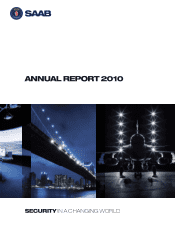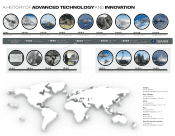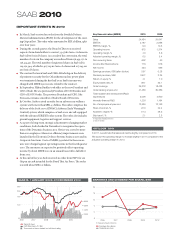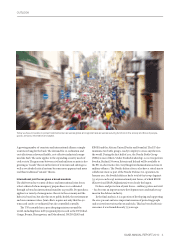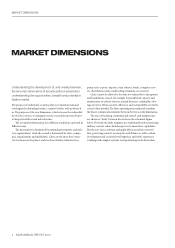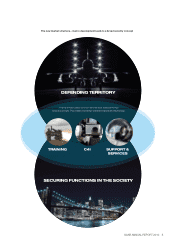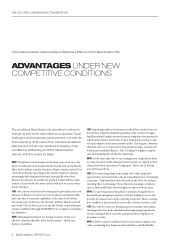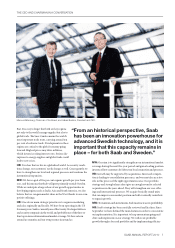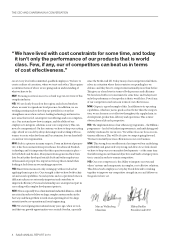Saab 2010 Annual Report Download - page 5
Download and view the complete annual report
Please find page 5 of the 2010 Saab annual report below. You can navigate through the pages in the report by either clicking on the pages listed below, or by using the keyword search tool below to find specific information within the annual report.
The long-term geopolitical trend toward supranational
structures where governments work together and a
security doctrine based on common interests and re-
sponsibilities are fundamentally changing conditions for
the defence industry. Financially strapped governments
and growing civil security needs favour flexible, cost-
effective enterprises like Saab.
In the last years, the world order and political system have incor-
porated greater diversity and larger network structures and seen a
shi in power and initiative to new players. International alliances –
political, economic and military – increasingly focus on protecting
common interests and the functions in a global ow-based society,
that we are all dependent on. Multilateral civil and military coalitions
are becoming more common – within, outside and between the
major political, economic and military blocs. To a growing degree, we
live by a security doctrine where common interests outweigh individ-
ual interests and where we share responsibility for defending these
interests. Globalisation and economic integration are generally lead-
ing to a shi in political power and economic resources from the
national level upward to the supranational and downward to the local
level. Far-reaching economic alliances between countries, major cit-
ies, NGOs and transnational companies today are considered impor-
tant actors in the international political system.
Technological developments are also creating change, and not
only in traditional armed conicts where information and commu-
nication systems have long been of critical importance. To a growing
extent, information and information systems are becoming weapons
and targets. e digitalisation of our world is creating new conict
zones and patterns that go beyond traditional antagonists. Conicts
can arise between nations and companies, as was the case between
China and Google in early , or between nations and organisa-
tions, which happened at the end of the year between the US and
WikiLeaks. In both cases, the conict revolved around transparency
and the extent to which it benets common interests. Both cases also
illustrate how technology is erasing traditional borders.
A world of alliances requires intergration
In terms of security policy, these changes have essentially made indi-
vidual governments less autonomous and increasingly forced them
to collaborate strategically and operationally. is has major impli-
cations for the defence industry in terms of both where development
work is focused and how it is nanced. Unique, solitary weapon sys-
tems are becoming less relevant in a world of alliances that demands
integration and coordination.
Global defence contractors cannot expect to fund their develop-
ment to the same extent with defence appropriations from individ-
ual governments and instead will have to nance more of the work
on their own or through international collaborations. To participate
in international projects, it is vital to have cutting-edge world-class
technology, making this one of the defence industry’s biggest chal-
lenges. is requires a well-focused portfolio and a large external
network. No one can be the best at everything.
Need for cost-effective solutions
In the former Western world, nancial struggles are forcing many
countries to slash their defence spending and be more ecient in
their purchases. is is reinforcing the current trend of buying fully
developed, proven weapon systems with documented performance,
which others also use and can be incorporated into larger co-ordi-
nated eorts. For the defence industry, this makes it necessary that
new programmes are commercially viable in multiple markets,
which in turn requires open markets with fair competition. e
defence market is the only one in the EU that has not fully adopted
the Treaty of Rome’s principle of free movement of goods, services,
capital and people, although progress is steadily being made. Eco-
nomic development is also driving this trend in the right direction.
Complex, advanced defence systems are also becoming more
expensive to develop. Even the US, which has by far the world’s larg-
est defence budget, has recently announced that it may mothball a
number of costly weapons projects and instead utilise existing tech-
nologies and systems to cut spending. It will buy more proven prod-
ucts and systems and may consider dealing more with international
suppliers if they oer better value for money.
CHANGING CONDITIONS FOR
THE DEFENCE AND SECURITY
INDUSTRY
2 SAAB ANNUAL REPORT 2010
OUTLOOK

